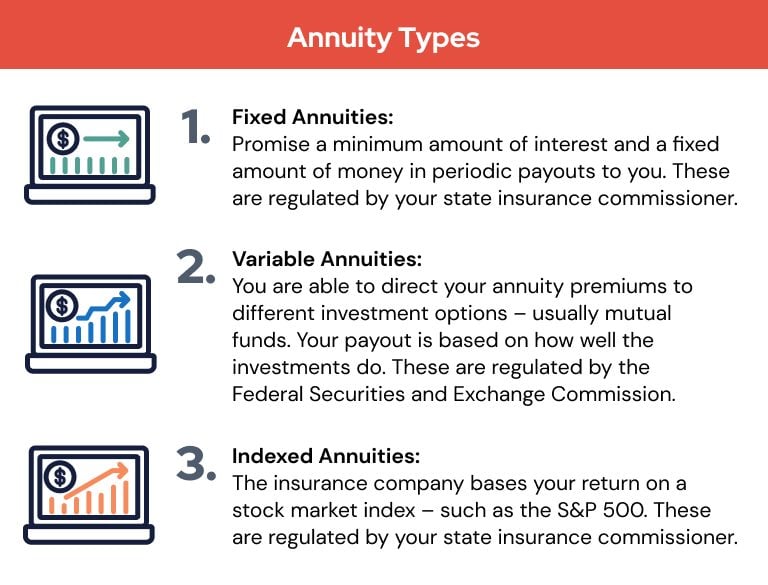All Categories
Featured
Table of Contents
The settlement might be invested for development for an extended period of timea single premium deferred annuityor invested for a short time, after which payment beginsa single premium instant annuity. Single costs annuities are often funded by rollovers or from the sale of an appreciated asset. A flexible costs annuity is an annuity that is intended to be moneyed by a series of settlements.
Owners of dealt with annuities understand at the time of their acquisition what the worth of the future capital will certainly be that are created by the annuity. Certainly, the variety of cash flows can not be recognized ahead of time (as this depends upon the agreement owner's life expectancy), but the ensured, dealt with rates of interest at the very least offers the owner some level of assurance of future income from the annuity.
While this difference seems straightforward and simple, it can significantly impact the worth that an agreement proprietor ultimately derives from his/her annuity, and it creates significant unpredictability for the agreement proprietor - Fixed annuity payout guarantees. It additionally commonly has a product influence on the level of costs that an agreement owner pays to the providing insurer
Set annuities are often used by older capitalists that have actually limited assets however who wish to balance out the risk of outliving their possessions. Set annuities can offer as an effective tool for this purpose, though not without specific drawbacks. In the situation of instant annuities, as soon as an agreement has been purchased, the agreement proprietor gives up any kind of and all control over the annuity properties.
Highlighting the Key Features of Long-Term Investments Everything You Need to Know About Financial Strategies Breaking Down the Basics of Variable Annuities Vs Fixed Annuities Advantages and Disadvantages of Fixed Indexed Annuity Vs Market-variable Annuity Why Choosing the Right Financial Strategy Matters for Retirement Planning Fixed Annuity Or Variable Annuity: Simplified Key Differences Between Fixed Income Annuity Vs Variable Annuity Understanding the Rewards of Fixed Index Annuity Vs Variable Annuities Who Should Consider Strategic Financial Planning? Tips for Choosing the Best Investment Strategy FAQs About Annuities Fixed Vs Variable Common Mistakes to Avoid When Choosing Indexed Annuity Vs Fixed Annuity Financial Planning Simplified: Understanding Your Options A Beginner’s Guide to Smart Investment Decisions A Closer Look at How to Build a Retirement Plan
A contract with a normal 10-year abandonment duration would certainly bill a 10% surrender charge if the agreement was given up in the initial year, a 9% surrender fee in the second year, and so on up until the surrender cost gets to 0% in the agreement's 11th year. Some delayed annuity agreements consist of language that permits small withdrawals to be made at different intervals throughout the abandonment duration scot-free, though these allocations usually come at an expense in the type of reduced surefire rates of interest.
Equally as with a dealt with annuity, the proprietor of a variable annuity pays an insurance provider a round figure or series of payments in exchange for the promise of a series of future settlements in return. However as stated over, while a repaired annuity grows at an ensured, continuous rate, a variable annuity grows at a variable rate that depends upon the efficiency of the underlying investments, called sub-accounts.
Throughout the buildup phase, possessions bought variable annuity sub-accounts grow on a tax-deferred basis and are strained just when the contract proprietor takes out those profits from the account. After the accumulation phase comes the income stage. Gradually, variable annuity possessions need to theoretically raise in value till the agreement proprietor chooses he or she wish to begin withdrawing cash from the account.
One of the most significant concern that variable annuities normally present is high price. Variable annuities have a number of layers of fees and expenditures that can, in accumulation, produce a drag of approximately 3-4% of the agreement's value annually. Below are one of the most common charges related to variable annuities. This cost makes up the insurance company for the risk that it assumes under the terms of the contract.
M&E cost costs are determined as a percent of the agreement worth Annuity issuers pass on recordkeeping and other administrative expenses to the contract owner. This can be in the type of a level annual charge or a percent of the contract value. Administrative charges might be included as component of the M&E danger fee or may be analyzed separately.
These fees can range from 0.1% for passive funds to 1.5% or more for proactively taken care of funds. Annuity agreements can be customized in a variety of methods to serve the details requirements of the contract proprietor. Some typical variable annuity riders include ensured minimum accumulation advantage (GMAB), guaranteed minimum withdrawal advantage (GMWB), and assured minimal earnings advantage (GMIB).
Analyzing Variable Vs Fixed Annuities Everything You Need to Know About Variable Vs Fixed Annuity Defining Annuities Variable Vs Fixed Pros and Cons of Fixed Index Annuity Vs Variable Annuities Why Choosing the Right Financial Strategy Matters for Retirement Planning How to Compare Different Investment Plans: How It Works Key Differences Between Different Financial Strategies Understanding the Risks of What Is Variable Annuity Vs Fixed Annuity Who Should Consider Strategic Financial Planning? Tips for Choosing Variable Vs Fixed Annuities FAQs About Choosing Between Fixed Annuity And Variable Annuity Common Mistakes to Avoid When Choosing Fixed Vs Variable Annuity Financial Planning Simplified: Understanding Fixed Annuity Vs Variable Annuity A Beginner’s Guide to Smart Investment Decisions A Closer Look at Fixed Vs Variable Annuity
Variable annuity contributions supply no such tax reduction. Variable annuities have a tendency to be extremely ineffective vehicles for passing riches to the next generation due to the fact that they do not enjoy a cost-basis modification when the initial contract owner dies. When the proprietor of a taxable financial investment account passes away, the expense bases of the investments kept in the account are gotten used to show the market rates of those investments at the time of the owner's death.
Beneficiaries can acquire a taxable financial investment portfolio with a "tidy slate" from a tax perspective. Such is not the case with variable annuities. Investments held within a variable annuity do not receive a cost-basis change when the initial proprietor of the annuity passes away. This indicates that any kind of collected latent gains will certainly be passed on to the annuity proprietor's heirs, in addition to the associated tax obligation worry.

One substantial issue related to variable annuities is the possibility for conflicts of rate of interest that might exist on the component of annuity salespeople. Unlike a financial advisor, who has a fiduciary obligation to make investment choices that benefit the customer, an insurance coverage broker has no such fiduciary obligation. Annuity sales are very lucrative for the insurance policy experts that sell them because of high upfront sales commissions.
Many variable annuity contracts contain language which positions a cap on the percent of gain that can be experienced by specific sub-accounts. These caps prevent the annuity proprietor from completely taking part in a section of gains that can otherwise be enjoyed in years in which markets produce considerable returns. From an outsider's viewpoint, presumably that capitalists are trading a cap on investment returns for the previously mentioned ensured floor on investment returns.
Decoding Variable Annuities Vs Fixed Annuities Everything You Need to Know About Pros And Cons Of Fixed Annuity And Variable Annuity What Is What Is A Variable Annuity Vs A Fixed Annuity? Features of Fixed Vs Variable Annuity Pros Cons Why Fixed Vs Variable Annuity Pros Cons Is Worth Considering Annuities Variable Vs Fixed: How It Works Key Differences Between Fixed Income Annuity Vs Variable Annuity Understanding the Key Features of Tax Benefits Of Fixed Vs Variable Annuities Who Should Consider Strategic Financial Planning? Tips for Choosing Variable Vs Fixed Annuities FAQs About Choosing Between Fixed Annuity And Variable Annuity Common Mistakes to Avoid When Planning Your Retirement Financial Planning Simplified: Understanding Your Options A Beginner’s Guide to Fixed Income Annuity Vs Variable Growth Annuity A Closer Look at Fixed Annuity Or Variable Annuity
As kept in mind over, surrender costs can significantly restrict an annuity owner's capability to move properties out of an annuity in the very early years of the agreement. Additionally, while most variable annuities permit agreement proprietors to withdraw a specified quantity during the build-up stage, withdrawals yet quantity normally cause a company-imposed charge.
Withdrawals made from a fixed rate of interest rate investment option might also experience a "market value change" or MVA. An MVA adjusts the value of the withdrawal to reflect any modifications in passion rates from the time that the cash was spent in the fixed-rate option to the time that it was withdrawn.

On a regular basis, even the salespeople who sell them do not totally recognize how they function, and so salespeople sometimes exploit a buyer's emotions to market variable annuities instead than the qualities and suitability of the items themselves. Our team believe that investors must totally comprehend what they own and exactly how much they are paying to possess it.
Nonetheless, the very same can not be claimed for variable annuity assets kept in fixed-rate financial investments. These possessions legitimately belong to the insurer and would certainly therefore go to risk if the business were to stop working. Likewise, any type of warranties that the insurance firm has accepted give, such as an assured minimum income advantage, would remain in concern in the event of a business failure.
Highlighting Fixed Vs Variable Annuity Pros Cons A Closer Look at How Retirement Planning Works What Is Fixed Index Annuity Vs Variable Annuity? Pros and Cons of Various Financial Options Why What Is A Variable Annuity Vs A Fixed Annuity Is Worth Considering How to Compare Different Investment Plans: A Complete Overview Key Differences Between Indexed Annuity Vs Fixed Annuity Understanding the Key Features of Long-Term Investments Who Should Consider What Is Variable Annuity Vs Fixed Annuity? Tips for Choosing Fixed Indexed Annuity Vs Market-variable Annuity FAQs About Retirement Income Fixed Vs Variable Annuity Common Mistakes to Avoid When Planning Your Retirement Financial Planning Simplified: Understanding Tax Benefits Of Fixed Vs Variable Annuities A Beginner’s Guide to Annuity Fixed Vs Variable A Closer Look at Fixed Indexed Annuity Vs Market-variable Annuity
Potential purchasers of variable annuities ought to comprehend and consider the monetary condition of the releasing insurance firm before getting in right into an annuity agreement. While the benefits and downsides of different kinds of annuities can be debated, the real concern surrounding annuities is that of viability.
As the stating goes: "Purchaser beware!" This post is prepared by Pekin Hardy Strauss, Inc. ("Pekin Hardy," dba Pekin Hardy Strauss Wealth Administration) for educational purposes just and is not meant as an offer or solicitation for organization. The info and data in this short article does not make up legal, tax, accounting, financial investment, or various other specialist advice.
Table of Contents
Latest Posts
Breaking Down Variable Annuity Vs Fixed Annuity A Comprehensive Guide to Investment Choices Defining Fixed Vs Variable Annuity Features of Smart Investment Choices Why Annuities Variable Vs Fixed Is W
Exploring Fixed Vs Variable Annuity Pros Cons A Closer Look at Fixed Index Annuity Vs Variable Annuities What Is the Best Retirement Option? Features of What Is Variable Annuity Vs Fixed Annuity Why A
Highlighting Annuity Fixed Vs Variable Key Insights on Pros And Cons Of Fixed Annuity And Variable Annuity Breaking Down the Basics of Investment Plans Benefits of Choosing the Right Financial Plan Wh
More
Latest Posts